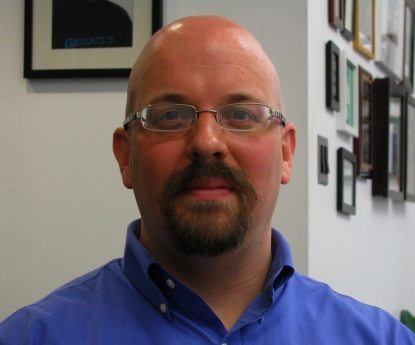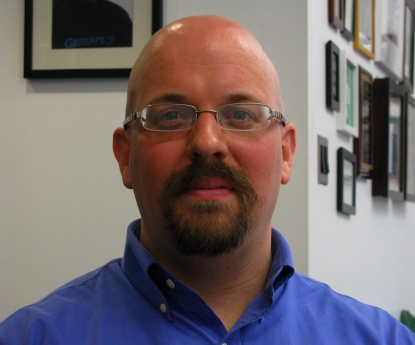 Phil RadfordPhoto: Kate SheppardGreenpeace USA’s announcement on Tuesday that the group is elevating its grassroots director to serve as the next executive director sends a clear signal that the 38-year-old environmental organization is focused on growing its membership and playing a lead role in rallying public support for big changes in U.S. energy and climate policies.
Phil RadfordPhoto: Kate SheppardGreenpeace USA’s announcement on Tuesday that the group is elevating its grassroots director to serve as the next executive director sends a clear signal that the 38-year-old environmental organization is focused on growing its membership and playing a lead role in rallying public support for big changes in U.S. energy and climate policies.
Phil Radford, 33, has run Greenpeace’s grassroots efforts for the past six years, and in that role he has helped double the organization’s membership and its budget. Greenpeace USA now boasts a $30 million annual budget, 240,000 members, and more than 400 canvassers pounding the pavement around the country. He takes the helm from John Passacantando, who stepped down in January to start a consultancy to advise institutional investors on environmental risks and opportunities.
In the past three years, the group also launched regional organizing efforts, with 26 coordinators currently working in cities across the country as part of the Project Hot Seat program (recently renamed Climate Rescue). Radford says it’s this kind of organizing that is going to be key to making the environmental movement into a viable political force in Congress and around the country.
“There are huge shifts across the country, massive shifts in the environmental community,” said Radford. “You have a realization in the environmental community that for too long we have played on the fringes and haven’t had political power.”
Noting that leaders of groups like MoveOn, 1Sky, and Rock the Vote all earned their stripes in grassroots organizing, Radford said it’s time for the environmental community to adopt more of those strategies.
“What’s missing right now is what Obama figured out and what other people figured out, which is in political campaigns in the past there just wasn’t enough money invested in on the ground organizing and using the internet really strategically to mobilize people,” said Radford. “You can be incredibly more effective if you put far more resources on the ground across the country.”
“The environmental community tends to focus too much on D.C., too much on negotiating from a point of weakness,” he continued. “Greenpeace’s role is to build the power on the ground across the country so the entire environmental community is negotiating from a place of strength.”
Radford said the environmental movement has focused too heavily in recent years on working the Washington game and delivering votes for politicians who are already sympathetic to the environmental cause, rather than building grassroots networks around the country. But as Obama demonstrated during the campaign last year, there’s much more that can and should be done at the local level, which is where Greenpeace’s hundreds of canvassers and regional organizers will focus their efforts going forward, he said, especially when it comes to the political debate over climate change policy.
“We are building power to pressure and persuade people,” Radford. “There’s a whole surge of people trying to figure out how to make the environmental community more powerful, rather than just nice people in suits with good ideas and white papers.”
Despite his young age, Radford has nearly two decades of grassroots organizing experience. He started his career in organizing at 14, when a friend’s mother took him to a hearing on a waste incinerator in his neighborhood on the west side of Chicago. Soon he was recruiting other kids to activism on the incinerator issue and organizing with the Student PIRGs in his area. He worked with PIRG through college, running campaigns in Chicago, Cleveland, and Kalamazoo, Michigan, and after college took an organizing fellowship with Green Corps.
From 1999 to 2001 Radford was a field organizer for Ozone Action, where he ran the group’s Global Warming 2000 campaign (and worked for Passacantando, who led Ozone Action before moving to Greenpeace in 2000). In 2001, Radford founded an organization called Power Shift, which led a campaign in 12 cities to invest in clean energy and efficiency, and also worked with financial industry heavyweights like Citigroup to create new financing mechanisms for green energy projects.
Radford officially assumes leadership of Greenpeace on April 27. He said the group will continue to focus much of its organizing on global warming, with plans to expand the number of activists on the ground and grow online organizing efforts.
With most of the attention in Washington currently focused on the draft of a climate bill introduced by Reps. Henry Waxman (D-Calif.) and Ed Markey (D-Mass.), Radford said his group will be pushing the two lawmakers to improve the measure. Right now, the specifics of much of the bill have not been finalized, including the auction of carbon credits and how the revenues would be spent. Greenpeace wants to see the offset provisions strengthened, and the funding for coal projects reduced.
“It’s better than any bill we’ve ever seen, and that’s good,” said Radford. “Our position right now is that it needs to be stronger, and we’re going to work with Congress to make sure that happens.”
Greenpeace will continue its various corporate campaigns, including an effort to get Kimberly-Clark, the world’s largest paper goods company, to start using Forest Stewardship Council-certified trees and recycled paper in its products. The group is also working with musical instrument-manufacturers like Fender and Gibson to push them toward using FSC-certified trees from Alaska’s Tongass National Forest, and with McDonald’s to curb deforestation in Brazil.
The grassroots experience is at least part of the reason the Greenpeace board tapped Radford for the new role. “For bold ideas to win on the climate crisis in Congress and boardrooms, we need thousands of courageous people to put themselves on the line for the Earth,” said Greenpeace Fund Board Chair David Chatfield. “Phil knows how to put ideas and people together for change.”
“What the board has said is that we see our role much more now as helping to build the movement that’s being created around global warming,” said Radford. “How are we getting out of the Beltway and really building the power of that movement?”




